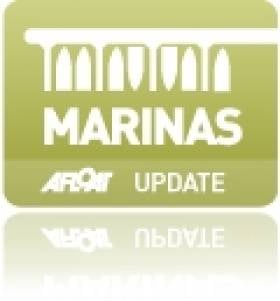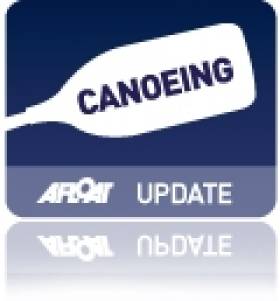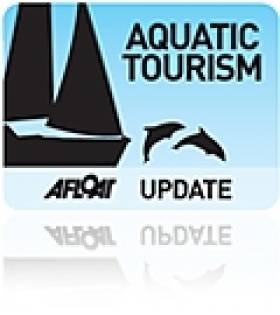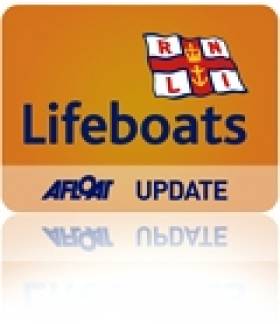Displaying items by tag: Sligo
Sligo Harbour Pontoon. Berthing for Yachts & Boats in Sligo
The pontoon jetty at Ballast Quay in Sligo is designed to be used primarily for day trips or shortterm stays in the City. The facility is made available for use by owners and authorised crew of leisure craft owned, managed and operated by Sligo County Council (SCC).
The pontoon is available to all local and visiting leisure craft and also available for long-term berthing either with or without crew.
The pontoon will also be available on a limited basis to sailing clubs wishing to host events during the sailing season.
Access to the Jetty area and to the pontoon is controlled by security coded locks, which (in the interests of security) are changed on a regular basis.
A pdf download of the Sligo County Council rules for the jetty is downloadable as a pdf document below
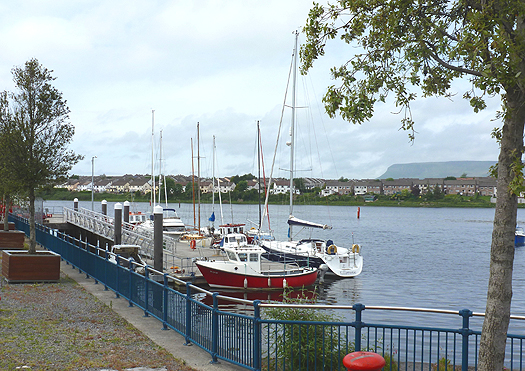
The boating pontoon at Ballast Quay in Sligo. Photo: WM Nixon
Sligo Surf Café Is A Foodie Success
#Surfing - A café-owning couple with twin passions for cooking and surfing have turned their successful business into an equally successful cookbook.
As reported on Surfers Village, Jane and Myles Lamberth were recently featured on the UTV series James Nesbitt's Ireland, which paid a visit to their eatery Shells Café in Strandhill, Co Sligo - a part of Ireland that's become a mecca for surfers the world over.
The Lamberths opened the café in 2010 and its popularity quickly led to the publication last year of The Surf Café Cookbook, featuring recipes for some of their favourite dishes from the menu.
Already a hit in world surfing hotspots from California to South Africa to Australia, its expected to get a bigger boost this summer with large orders from hip US chains.
Surfers Village has more on the story HERE.
Sligo Bay RNLI Readies To Give It Some Welly This Mayday
#RNLIMayDay - Sligo Bay RNLI in Rosses Point is counting down this week to Mayday, the charity’s annual national fundraising campaign in Ireland.
Now in its second year and running nationwide, from this Wednesday 1 to Bank Holiday Monday 6 May the RNLI is asking the public to 'give it some welly' and help its volunteers to continue to save lives at sea.
Encouraging the people of Sligo to support their local lifeboat station this week is one man who experienced first-hand the lifesaving work of the RNLI volunteers based in Rosses Point, when he was rescued in 2011.
"I guess it is always nice to know the orange boat will be coming up the bay looking for you if you get into difficulty," he said, "so remember to call as soon as you know you are in trouble."
With a fun theme in mind, the Mayday appeal is calling on people to lend their support by either purchasing a special RNLI Mayday yellow welly key ring which will be on sale for €2 in various schools in Sligo during the campaign, or by organising their own yellow welly fundraising event.
The yellow welly is an essential piece of the RNLI volunteer lifeboat crew member’s kit. Waterproof with steel-capped toes, the specially designed boots keep the volunteer crew’s feet warm and dry while also protecting them in dangerous conditions on deck.
During gale force winds, rain and ice, keeping a sure footing can literally mean the difference between life and death for volunteers. A pair of yellow wellies for crew members costs €50.
The public can also join in the social media campaign and help the RNLI raise awareness of its lifesaving work this Mayday.
All you have to do is take a photo of yourself holding an RNLI Mayday yellow welly key ring and tweet the phrase ‘I am giving it some welly for the RNLI this Mayday’ including the hashtag #RNLIMAYDAY and mentioning @RNLI.
For more information on how you can get involved or where you can purchase a key ring, log on to rnli.org/mayday
Sligo Kayak Training Courses For Anyone New To Canoes
#Kayaking - Beginners are more than welcome to the Sligo Kayak Club as it prepares to host a series of training courses for anyone new to canoes this spring and summer, according to the Leitrim Observer.
This Level 2 training course will provide prospective kayakers with the basic skills and safety practices they need to get paddling on the water.
And on completion of the course, participants can become full members of the Sligo Kayak Club and avail of further training opportunities.
The €80 course - the first of which begins next Tuesday 9 April - will run for two hours every Tuesday evening over six weeks, with a Level 2 skills assessment on the final week. Gear rental is covered by the price (except for wetsuits and suitable footwear).
The Leitrim Observer has more on the story HERE.
New Angling Guides and Salmon Bait Restrictions
#Angling - Inland Fisheries Ireland has recently added two new guides to its list of resources for anglers fishing in Ireland.
The West of Ireland Sea Angling Guide covers the region from Westport, in Clew Bay, south to the rocky headlands of North Clare, including Galway Bay, Connemara, Killary, Louisburgh, Clew Bay, and the offshore islands of Inisbofin, Inisturk and the Aran Islands.
The guide is in no way comprehensive, and the list of marks and venues is just a sample of what is available across the region's waterways. There are literally hundreds of shore marks in the region that have rarely, if ever, been fished, but the potential waiting to be explored is immense. Getting off the beaten path and trying a new mark may produce the fish of a lifetime.
In addition, the County Sligo Game Angling Guide covers the main game angling waters in the district. It contains information on the location of each fishery as well as details in relation to contacts, permitted angling methods, angling seasons, etc.
Meanwhile, IFI has received numerous submissions from individual anglers, angling organisations and angling tourist providers regarding restrictions on the use of prawn/shrimp as a salmon angling bait on the River Suir for the 2013 season.
IFI is interested to hear the views of other angling stakeholders or from those who wish to make further submissions.
Submissions can be made to IFI Clonmel by email at [email protected] or by post to Inland Fisheries Ireland, Anglesea Street, Clonmel, Co Tipperary.
The closing date for receipt of submissions is 28 February 2013.
Surfing Ireland's 'Emerald Slabs' Caught On Video
#Surfing - Check out this stunning video of Portuguese surf pro Nic Von Rupp who cancelled his winter trip to Hawaii last week to take on what Surfer magazine calls 'Ireland's Emerald Slabs'.
Towing out to the storm-fuelled swells of Mullaghmore, Von Rupp shows just how it's done as the world's big wave surfing elite flocked to Sligo for the Billabong Tow-In Session.
Big Waves Come to Mullaghmore After Long Wait
#Surfing - Some of the world's top big wave surfing talent enjoyed the 'day that almost never was' at Mullaghmore in Sligo on Sunday.
As the video above shows, competitors in the long-delayed Billabong Tow-In Session finally got a chance to prove their mettle after two amber alerts in a week for the international event, pushed back from last year after a calm storm season.
Confidence was high as the storm front that has been battering Ireland for the past two days made its way across the Atlantic, bringing with it the giant swells needed to green-light the action.
Big wave surfers being secretive sorts, due to the dangerous nature of offshore tow-in surfing and their determination to keep their favourite spots 'just for them', we don't yet have results of the action, or even confirmation that the waves were big enough to count!
But what we do know is that the likes of Billabong XXL 2013 Ride of the Year nominee Peter Conroy were present and ready to tackle the colossal walls of water Mother Nature was set to provide.
Meanwhile, Met Eireann warns that gale force winds are expected to continue today (29 January) with southwesterly gusts of up to 110 km/h possible. Those in coastal areas have been warned to exercise caution.
Surfers On Amber Alert for Third Annual Tow-In Session
#Surfing - Some of the world’s best big wave surfers were last week hurriedly making their way to Ireland to compete in the third annual Billabong Tow-In Session at Mullaghmore in Co Sligo.
Event organisers gave the amber light for the one-day event on the strength of a giant swell that was forecast to reach Mullaghmore this past Monday.
As previously reported on Afloat.ie, the waiting period for the event commenced in November 2012 and finishes on 1 March this year. Organisers only need one day of giant waves to stage the event.
The huge North Atlantic swell headed Ireland’s way looked like providing surf big enough to stage the event but, most importantly, the forecast giant waves were expected to be accompanied by light and favourable winds.
Last year’s event was cancelled because waves in excess of 20 feet in height, with favourable winds, didn’t arrive during the four-month waiting period. But contest director Paul O’Kane said on the current forecasting models it looked like there would be clean and perfect 20-foot waves at Mullaghmore on Monday.
“For a big wave surfing contest such as this that’s about the minimum size we need to run the event,” he said. “But because the ocean conditions will be so clean and perfect on Monday that’s why we have decided to go to amber alert... This will give all the Irish competitors and those coming from overseas enough time to get here and be well organised with their equipment.
For safety reasons the event is restricted to invitees only. Because lives are at stake, only those surfers with recognised big wave experience have been invited to compete. Competitors are also expected to be well versed and qualified in the all necessary rescue and water safety procedures.
Mullaghmore, along with Aileen’s at the Cliffs of Moher in Co Clare, is fast gaining a reputation as one of the most fearsome and challenging big wave locations in the world.
Irish surfers competing in the event are Richie Fitzgerald and Peter Craig (Donegal), Dave Lavelle and Mikee Hamilton (Sligo), Peter Conroy and Ollie O’Flaherty (Clare), Hugh Galloway (Galway) and Al Mennie (Antrim). The international field this year also includes competitors from Ireland, Hawaii, USA, Great Britain, France, Spain, Germany, Tahiti and South Africa.
The event is sanctioned by the Irish Surf Rescue Club and the Irish Surfing Association. Here's hoping we learn soon if the day was a roaring success or a wipeout!
Sligo's Seaweed Spa A Hit With Locals and Tourists Alike
#Tourism - How's this for a unique winter break in Ireland - a visit to a century-old seaweed bathhouse in Sligo, anyone?
That's what Guardian writer Nick Fisher did recently when he and his family spent a week in the north-west to partake of Kilcullen's Seaweed Baths, right next to the shore at Enniscrone beach.
Angling is the big tourism draw for the region, now that the salmon season is well underway, with the River Moy providing all the sport a caster could want at any level.
But it's the seaweed baths - fed with water and fresh seaweed from Enniscrone Bay - that put a unique stamp on the whole experience, according to Fisher.
"People with skin conditions... as well as sportsmen and women love these baths," he writes. "Many of the local pensioners have season tickets ('To warm their old bones in the winters') and I'm told it is a very popular hangover cure.
"After the hot silky seaweed soak, the stinging, cleansing, pins-and-needles of the cold seawater shower leaves a bather feeling newly minted."
The Guardian has more on the story HERE.
Sligo Sea Shanty Festival Returns For Fourth Year
#MaritimeFestivals - Running for the last three years, Sligo Bay RNLI is once again preparing for the Sea Shanty Festival in Rosses Point later this summer, with all proceeds going to the lifeboat station.
"The festival is a celebration of the long maritime tradition of Rosses Point and the Sligo area," as festival committee chair Willie Murphy explained last year.
"Shanties were working songs used on board sailing ships. The songs were mostly sung when the job involved several crew members working in rhythm together."
One of the many groups that have performed in the past is The Drunken Sailors from Germany, who have written a song inviting people back to Sligo Bay for the 2013 festival from 14-16 June.
The group’s story goes that back in the summer of 2012, the Drunken Sailor Shantymen were infected by the ‘Sligo Bay Virus’, and they asked their witch-doctor what medicine would help.
"You were infected by a well-known serious music virus out of the north-west of Ireland," they were told. "And the only think what may help, is to sing a song which tells a story of Sligo Bay.
"But take the medicine without any alcohol or other drugs, sing a great song for all friends of shanty music and you will get better!"
With this advice, the brave Drunken Sailor Shantymen started to sing the song you can hear in the video above, and which they think may move all famous artists to come back to Rosses Point Sea Shanty Festival later this year.


























